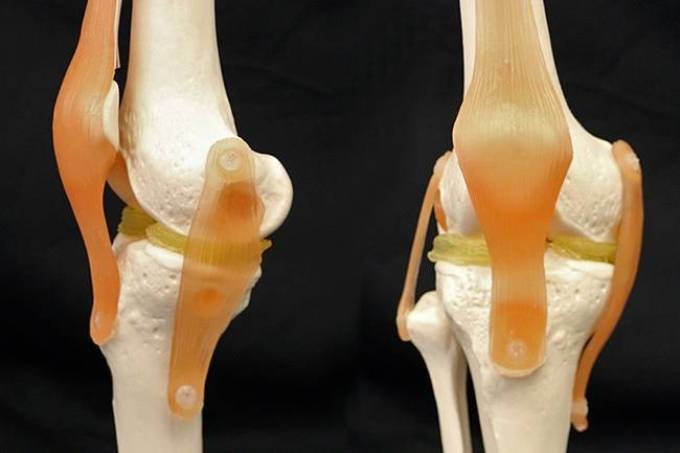Apr 20 2017
A team of researchers at Duke University have developed a cartilage-mimicking material, which they hope will one day allow surgeons to 3D print knee replacement parts that are custom-shaped to suit each patient’s anatomy.
 To demonstrate how their 3D-printable, cartilage-mimicking material might work, the researchers used a $300 3D printer to create custom menisci for a model of a knee. (Photo credit: Feichen Yang)
To demonstrate how their 3D-printable, cartilage-mimicking material might work, the researchers used a $300 3D printer to create custom menisci for a model of a knee. (Photo credit: Feichen Yang)
Human knees have a pair of integral shock absorbers known as the menisci. These ear-shaped pieces of cartilage, resting between the shin and thigh bones, cushion the steps while walking. But a lifetime of wear-and-tear -- or a single wrong step during a game of tennis or soccer -- can permanently damage these key supports, resulting in pain and an increased chance of developing arthritis.
The hydrogel-based material developed by the researchers is the first of its kind to match human cartilage in elasticity and strength while also remaining 3D-printable and stable within the body. To show how it might work, the team used a $300 3D printer to build custom menisci for a plastic model of a knee.
“We’ve made it very easy now for anyone to print something that is pretty close in its mechanical properties to cartilage, in a relatively simple and inexpensive process,” said Benjamin Wiley, an associate professor of chemistry at Duke and author on the paper, which can be viewed online in ACS Biomaterials Science and Engineering.
Once a person reaches adulthood, the meniscus has limited capacity to heal on its own. Surgeons can attempt to repair a damaged or torn meniscus, but mostly it must be completely or partially removed. Existing implants either do not match the elasticity and strength of the original cartilage, or are not biocompatible, meaning they do not support the development of cells to promote healing around the area.
Recently, materials called hydrogels have become increasingly popular as a replacement for lost cartilage. Hydrogels are biocompatible and possess a very similar molecular structure to cartilage: on closer observation, a web of long string-like molecules with water molecules squeezed into the gaps can be seen.
However researchers have struggled to develop recipes for artificial hydrogels that are 3D-printable or that are equal in strength to human cartilage.
“The current gels that are available are really not as strong as human tissues, and generally, when they come out of a printer nozzle they don’t stay put -- they will run all over the place, because they are mostly water,” Wiley said.
Feichen Yang, a graduate student in Wiley’s lab and author on the paper, tried to blend two different types of hydrogels -- one stronger and stiffer, and the other stretchier and softer -- to produce what is called a double-network hydrogel.
The two networks are woven into each other. And that makes the whole material extremely strong.
Yang
By altering the relative quantities of the two hydrogels, Yang could modify the elasticity and strength of the mixture to attain a formula that best suits that of human cartilage.
He also added in a special element, a nanoparticle clay, to create the mock-cartilage 3D-printable. The clay enables the hydrogel to flow like water when put under shear stress, just like being squeezed through a small needle. But once the stress is removed, the hydrogel instantly stabilizes into its printed shape.
3D printing of other custom-shaped implants, including cranial plates, hip replacements, and even spinal vertebrae, is already performed in orthopedic surgery. These custom implants are based on virtual 3D models of a patient’s physical framework, which can be acquired from magnetic resonance imaging (MRI) scans or computer tomography (CT).
Meniscus implants could also profit from 3D printing’s ability to develop customized and intricate shapes, the researchers say. “
Shape is a huge deal for the meniscus. This thing is under a lot of pressure, and if it doesn’t fit you perfectly it could potentially slide out, or be debilitating or painful.
Wiley
“A meniscus is not a homogenous material,” Yang added. “The middle is stiffer, And the outside is a bit softer. Multi-material 3-D printers let you print different materials in different layers, but with a traditional mold you can only use one material.”
Yang performed a simple demonstration where a CT scan of a plastic model of a knee was taken and then the information from the scan was used to 3D print new menisci using his double network hydrogel. The entire process, from scan to finished meniscus, took just about a day, he says.
This is really a young field, just starting out. I hope that demonstrating the ease with which this can be done will help get a lot of other people interested in making more realistic printable hydrogels with mechanical properties that are even closer to human tissue.
Wiley
This research was supported by start-up funds from Duke University and grants from the National Science Foundation (ECCS-1344745, DMR-1253534).